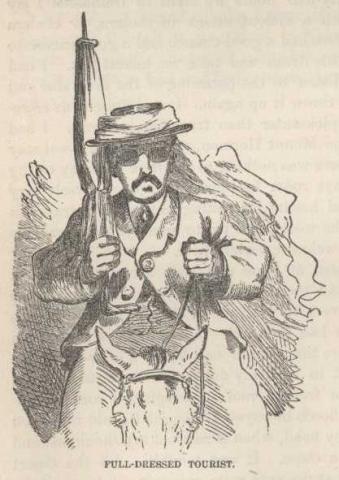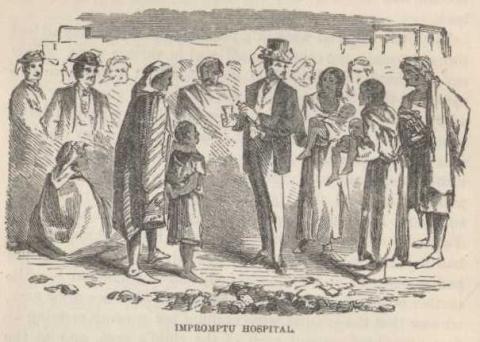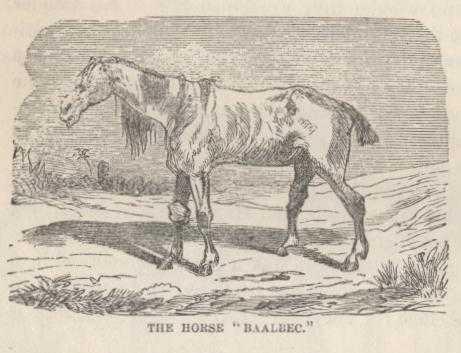scott
10 May 2012
Of great interest to me, in this chapter, is the dress and behaviour of the tourists, especially their self-justified vandalism. Twain is amused by the former and offended by the later. He remarks on a somewhat related behaviour of the doctor. Once knowledge that a doctor was present in one of the Syrian villages they'd stopped in, the people flocked to him "... and upon his face was written the unquestioning faith that nothing on earth could prevent the patient from getting well now." The chapter also notes the loss of another childhood fantasy, Arabs and their horses. "Look at poor cropped and dilapidated "Baalbec," and weep for the sentiment that has been wasted upon the Selims of romance!"
Reading Date
May 1, 2012
SL Venue
Botanical Gardens Story Telling Pavilion
- Log in to post comments



Twain Chapter Comments
Cholera
scott Wed, 12/05/2018 - 13:21
I made a comment about Twain's claim of suffering from cholera on the page associated with chapter 44. Cholera is a rather dubious claim, dysentery perhaps?
Where St Paul was converted
scott Wed, 12/05/2018 - 13:22
Ian Strathcarron, in Innocence and War, relates his experience in trying to locate this spot. It's rather surprising that it is not known as a tourist location. "In case anyone is interested in finding it I shall give it the spelling in the only English sign for it: "Kawkab". Samir asks for "Tal Kawkab". (In ten years driving foreigners around Samir has never been asked to go there before.) It is signposted in the town of Al Kiswah, some nine miles south-west of Damascus, and is half a mile to the east of that. " They follow the sign from Al Kiswah and find a church about forty (40) years old, the Abbey of St. Paul the Messenger.
Quneitra - Where Nimrod is buried
scott Wed, 12/05/2018 - 13:23
This is the village of melancholy dogs and sore-eyed children. Ian Strathcarron visited this site, or tried to at any rate, and found it in the no mans land between Israel and Syria. "I thought it best not to mention to the Minister's assistant that Quneitra sounded so grim when Mark Twain camped there that the Israeli-flattened scene of devastation might well be an improvement."
Nimrod's Fortress
scott Wed, 12/05/2018 - 13:25
Two hours after leaving El Yuba Dam, Twain and the Pilgrims reached the "foot of a tall isolated mountain, which is crowned by the crumbling castle of Banias, the stateliest ruin of that kind on earth, no doubt. It is a thousand feet long and two hundred wide, all of the most symmetrical, and at the same time the most ponderous masonry. The massive towers and bastions are more than thirty feet high, and have been sixty." Now known as Nimrod's Fortress. Ian Strathcarron notes that at the time Twain visited the area it was known as Qala'at Namrud, the Castle of the Large Cliff. "More recently Judaic enthusiasts, noting the similarity between the Arabic Namrud and their own Nimrod, have grafted the Genesis legend onto the castle...". Twain, not knowing when it was built nor by whom, assigned it to high antiquity. Strathcarron reports that it has since been determined to have been built by Salah al-Din's nephew Al-Aziz "to pre-empt the expected assault on Damascus from Acre by the Sixth Crusade." The attack never occurred, the crusaders left Acre and the castle fell into disrepair. Strathcarron reports that "When the Ottomans arrived two hundred years later they used the castle as an up-market prison for disfavored officers and gentlemen."
El Yuba Dam
scott Wed, 12/05/2018 - 13:26
The Pilgrims and Twain left Qunietra, called Jonesborough by the Pilgrims, early in the morning. "At noon we halted before the wretched Arab town of El Yuba Dam, perched on the side of a mountain, but the dragoman said if we applied there for water we would be attacked by the whole tribe, for they did not love Christians. We had to journey on." Ian Strathcarron notes that El Yuba Dam translates to something like Crater Spring and the place is now called Odem. It is the home of Odem Mountain Winery Ltd, a maker of kosher wine.
The Journey: Then and Now
scott Wed, 12/05/2018 - 13:27
Mark Twain, along with the Pilgrims and maybe a couple of Sinners cross from Syria into the Holy Land, what is now called the Golan Heights. He didn't much enjoy it but suffered no political difficulties in the crossing. Ian Strathcarron, in 2010, didn't have the luxury of a straight traverse. He arrived at the border area but was unable to proceed due to political issues in the region. His book, Innocence and War has a chapter devoted to what he has called "the detour" (a chapter title). He returns back to his boat, in Beirut and takes a circuitous sail from there to Haifa. This chapter provides an excellent example of the absurdity of politics. Anyway, he finds his way back to the Golan Heights. This time from the Israeli side.
Excursion Itinerary 16 Sept
scott Wed, 12/05/2018 - 13:29
SLC and companions departed Damascus at noon, camping that night at Kefr Hauwar;
QC arrived at Mt. Carmel, 10:00 a.m., and departed again at noon, arriving at Jaffa (now part of Tel Aviv), 8:00 p.m.
17 Sept SLC and companions departed Kefr Hauwar in the morning and camped that night at Baniyas, formerly the ancient city of Caesarea Philippi.
Kefr Hauwar
scott Wed, 12/05/2018 - 13:30
This site can not be located with Google Maps but it is referred to as the usual camping site on the journey between Damascus and Baniyas (Caesarea Philipi). The Rumsy map has a location of Kefr Hauwar approximately half way between Banias and Damascus, just north of Sasa. It is located in the el Bellan Wady. I have been unable to locate a similar site on a current map.